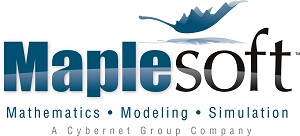Maple Drastically Reduces Downtime of Steam Turbines by Improving the Ultrasonic Testing of Rotor Blades
Rotek, the maintenance branch of Eskom, South Africa’s state-owned electricity provider, is using Maple, the technical computing software from Maplesoft, to design a comprehensive pre-inspection simulation model for use in the ultrasonic inspections of turbine blades in power plants. Rotek needed to design a pre-inspection simulation model to reduce the time required to inspect the last-stage blade roots of the rotors in the low pressure areas of steam turbines. Using Maple, Rotek was able to create a precise model of the ultrasonic inspection routine.
Rotek, the maintenance branch of Eskom, South Africa’s state-owned electricity provider, is using Maple, the technical computing software from Maplesoft, to design a comprehensive pre-inspection simulation model for use in the ultrasonic inspections of turbine blades in power plants. Because minimizing downtime in power plants is critically important, the use of Maple is allowing inspections to be conducted more quickly and more precisely than ever thought possible.
Steam turbines extract thermal energy from pressurized steam, which is used to generate the turbine’s rotary motion, which then drives the electrical generator. There are three distinct parts to the steam turbine: high pressure, intermediate pressure and low pressure. When in use, turbine blades in the low pressure area are one of the most highly-stressed components of the machine. A critical element of a blade (and an area of greatest vulnerability) is the last stage blade root, the portion of the turbine blade that connects to the rotor. These blades are subject to enormous centrifugal forces during the turbine operation, especially during the start-up and shutdown of the machine, and the constant force can ultimately result in damage to the blade. Most common is an initial crack in the blade root which can propagate deeper into the blade. Therefore, the blades, especially blade roots, must be inspected and maintained regularly.
The turbine blades must be inspected in situ (in position) because removal of the blades for inspection is time consuming. However, the examination of the blades is complex due to the location of the blades, the complexity of the blade shape, limited access points for inspection and the varying surfaces of the rotor and blades on which to install inspection tools. The inspection must be well planned to avoid unnecessary downtime of the machine.
 Ultasonic testing of the blades must be preformed regularly.
Ultasonic testing of the blades must be preformed regularly.
Ultrasonic methods are used to carry out the examination of the turbine blades. In order to minimize the time required for inspection and to optimize the inspection results, Rotek needed to create a comprehensive pre-inspection simulation model. This model would specify an accurate, detailed plan...
+ Read more
Ultrasonic methods are used to carry out the examination of the turbine blades. In order to minimize the time required for inspection and to optimize the inspection results, Rotek needed to create a comprehensive pre-inspection simulation model. This model would specify an accurate, detailed plan for the ultrasonic examination with the highest reliability. Using Maple, Rotek was able to simulate the analytical process that included: scanning surfaces, curves of the defect location and optimal shot conditions. These results could then be entered into CIVA non-destructive testing software, to determine the optimal equipment settings. With these results, Rotek could perform an ultrasonic examination with the greatest confidence and reduce the turbine downtime needed to conduct the examination.
“Using Maple, we are able to obtain a precise model of the inspection parameters before the actual testing takes place,” says Jean Michel Puybouffat, leader of Rotek’s in-service inspection team. “Using this model, we can better understand the exact equipment settings and most critical shot locations, thereby reducing the time normally required for set-up and performance of the actual inspection.”
Different factors influence the conditions of an ultrasonic examination, such as the shape of the defect areas, the shape of the scanning surfaces and the shot conditions required for best detection. Using Maple’s advanced mathematical capabilities, unique inspection conditions can be represented. The ultrasonic beam conditions depend primarily on the scan surface relative to the target defect position. Due to the inherent complexities of the blade root, the use of a 2D phased array is essential. Unlike conventional arrays, a 2D phased array allows the steering, transmitted and received waves to target the suspected failed area. In this case, an array belt of 7 arrays was used for the extrados (the exterior curve of the blade) and an array belt of 6 arrays was used for the intrados (the interior curve of the blade). Maple set the parameters for optimal shot positions (refraction, skew, tilt, pan and focal law).
The result was a breakthrough method for last stage blade root inspection. Using Maple, the entire inspection package was completely predesigned and evaluated prior to implementation. The model ensured efficiency, reliability and scanning optimization when the actual ultrasonic inspection was performed. Says Mr. Puybouffat, “the use of Maple to predesign our inspection routines has generated fantastic time and cost savings to our company.” The end result was a massive reduction in costly machine downtown: the time required to perform an inspection of a single rotor with 88 blades has been reduced from 7 days to 2 days.
- Read less
Published by Maplesoft, Inc. on Feb 08, 2017

Maplesoft, Inc.
T 800-267-6583
519-747-2373
F: 519-572-8787
Address
615 Kumpf Drive
Waterloo, ON
N2V 1K8
Canada
View map





